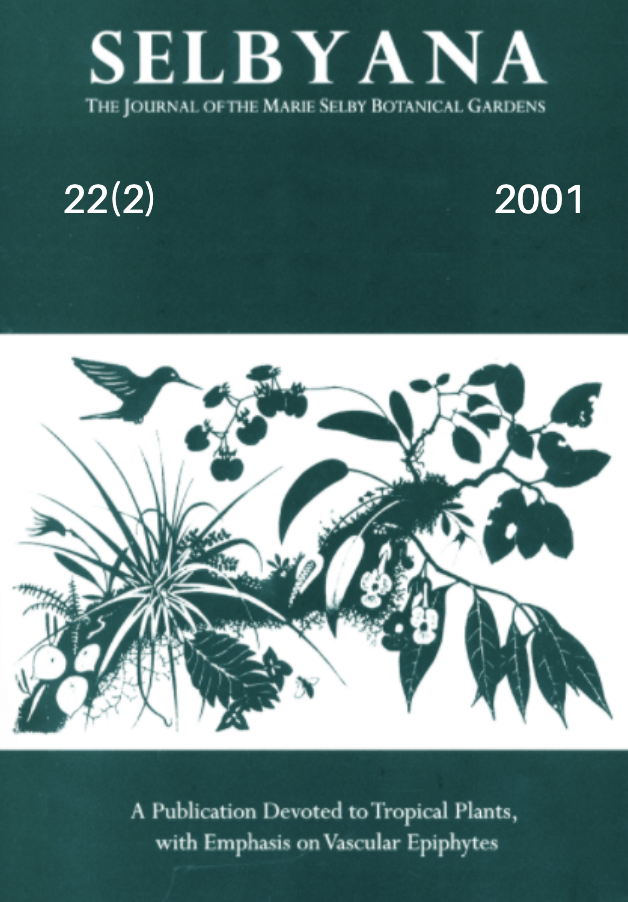Abstract
Hypotheses about differences in herbivory between species, young and mature leaves, and understory and canopy leaves were tested in 1994 and 1995. The authors measured herbivory in the following three tree species representing different phytogeographical affinities in a tropical montane cloud forest in Mexico: Carpinus caroliniana (temperate deciduous), Oreopanax xalapensis (neotropical broadleaved-evergreen) and Turpinia insignis (American-Asiatic broadleaved-evergreen). Foliar buds were tagged in 20 trees per species, and randomly selected leaves were collected when young (1-2 months) or mature (6-8 months), in both the understory and canopy. A total of 5804 leaves were measured for leaf area losses (% holes plus damaged areas). Total herbivory was expressed as % area loss in mature leaves, while herbivory rate was expressed as % area loss/month. Specific leaf area and toughness were determined in subsamples. Differences in total herbivory and herbivory rates were observed among species. Total herbivore damage in mature leaves was as follows: Carpinus 2.7% ± 0.2, Oreopanax 9.7% ± 4.3, and Turpinia 8.0% ± 0.6. Overall, herbivory rates were higher in young (3.6 ± 0.5 %/month) than in mature leaves (1.9 ± 0.3 %/month), and herbivory rates were higher in understory (3.3 ± 0.5 %/month) than in canopy leaves (2.2 ± 0.3 %/month). Within a species, however, only Oreopanax showed higher rates as significant trends. Herbivore damage apparently was not related to specific leaf area and toughness; however, it may be related to foliar phenological characteristics. En un bosque de neblina en Veracruz, México, se probaron hipótesis sobre herbivoría diferencial entre especies, hojas jóvenes y maduras, y hojas del sotobosque y del dosel. En 1994 y 1995, las especies estudiadas fueron Carpinus caroliniana (templada caducifolia), Oreopanax xalapensis (neotropical perennifolia) y Turpinia insignis (Americana-Asiática perennifolia). Se marcaron yemas foliares en 20 árboles por especie; se colectaron al azar hojas jóvenes (1-2 meses) o maduras (6-8 meses) en el sotobosque y en el dosel. En 5804 hojas se midió el porcentaje de área foliar perdida (% hoyos y área dañada). La herbivoría total se expresó como % de área perdida en hojas maduras, y la tasa de herbivoría se expresó como % área perdida/mes. El area foliar específica y la dureza se determinaron en submuestras. El porcentaje de herbivoría total en hojas maduras fue: Carpinus 2.7% ± 0.2, Oreopanax 9.7% ± 4.3, y Turpinia 8.0% ± 0.6. En general, la tasa de herbivoría fue mayor en hojas jóvenes (3.6 ± 0.5 %/mes) que en hojas maduras (1.9 ± 0.3 %/mes), y también fue mayor en el sotobosque (3.3 ± 0.5 %/mes) que en el dosel (2.2 ± 0.3 %/mes). Pero al considerar especies, solo Oreopanax mostró estas tendencias significativamente. Los niveles de herbivoría, aparentemente no estuvieron relacionados con área foliar específica o dureza, pero parecen estar relacionados con características fenológicas foliares.
Open Access and Copyright Notice
Selbyana is committed to real and immediate open access for academic work. All of Selbyana's articles and reviews are free to access immediately upon publication. There are no author charges (APCs) prior to publication, and no charges for readers to download articles and reviews for their own scholarly use. To facilitate this, Selbyana depends on the financial backing of the Marie Selby Botanical Gardens, the hard work and dedication of its editorial team and advisory board, and the continuing support of its network of peer reviewers and partner institutions.
Authors are free to choose which open license they would like to use for their work. Our default license is the Creative Commons Attribution-NonCommercial 4.0 (CC BY-NC 4.0). While Selbyana’s articles can be copied by anyone for noncommercial purposes if proper credit is given, all materials are published under an open-access license with authors retaining full and permanent ownership of their work. The author grants Selbyana a perpetual, non-exclusive right to publish the work and to include it in other aggregations and indexes to achieve broader impact and visibility.
Authors are responsible for and required to ascertain that they are in possession of image rights for any and all photographs, illustrations, and figures included in their work or to obtain publication or reproduction rights from the rights holders. Contents of the journal will be registered with the Directory of Open Access Journals and similar repositories. Authors are encouraged to store their work elsewhere, for instance in institutional repositories or personal websites, including commercial sites such as academia.edu, to increase circulation (see The Effects of Open Access).
